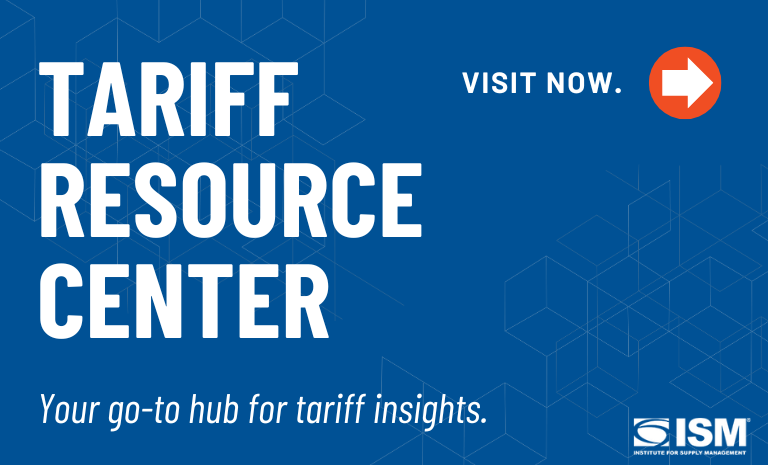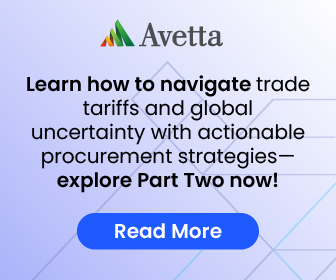Avoiding Panic in Turbulent Times: Navigating Tariffs for Smarter Procurement
Sponsored by Avetta

Gain powerful insight into navigating perceived and real threats, including tariffs and geopolitical challenges.
Key Takeaways
- Renew your focus on disciplined planning and analysis .
- Reaffirm long-term strategies to reduce and eliminate risk.
- Support your team with a steady hand, clear vision and overcommunicate to all levels of the organization.
- Engage with your suppliers in collaborative discussions to navigate risk together.
As concerns grow over U.S. trade policy, shifting consumer sentiment and evolving market reactions, procurement leaders are bombarded with data but offered little clarity. While it’s critical not to ignore potential impacts of tariffs or deregulation, reactionary behavior can lead to costly missteps. Instead, a calm consistent, and strategic approach is essential.
Two core concepts from retirement investing offer relevant insight for procurement:
- Dollar cost averaging promotes consistent action over time rather than attempting to time the market. Applied to procurement, this means phasing in changes — new suppliers, redesigns or specification shifts — rather than reacting all at once.
- Set a long-term strategy and stick to it. Revising a long-term plan is smart; abandoning it in response to market turbulence is not. As in investing, trying to “time” procurement moves in response to every shift in the market leads to poor outcomes.
Ask the right questions. Take a step back and consider:
- What are your annual operating goals?
- What risks threaten those goals?
- Has anything changed significantly enough to warrant action?
Procurement leaders must resist falling into a pattern of crisis response. True supply chain resilience comes from shifting beyond individual risk events toward a broader approach focused on analysis, strategy and action.
Is Your Organization Panicking or Remaining Calm?
Evaluate your team’s current posture. Is leadership focused on calm analysis, scenario planning, and clear communications — or is chaos driving reactive, inefficient decisions?
Consider your risk monitoring processes. If certain suppliers were in poor health before, they’re likely still vulnerable — maybe more so. Are you acting on this data or simply collecting it? What are supplier scorecards telling you about cost, delivery, and lead times?
Look at trends. Are you segmenting suppliers by NAICS codes or categories and noticing shifts in risk profiles? Is your "red alert" list growing?
Also, consider how often you're monitoring. Daily checks can cause overreaction. Instead, focus alerts on critical categories and suppliers while watching macro trends over longer periods.
Sifting Through the Noise: Tariffs and More
Recent tariff changes on goods from countries like Canada, Mexico, and the E.U. — ranging from 10 percent to 50 percent — have created significant uncertainty. In some cases, prior sourcing strategies, such as routing through Mexico or Canada before final import to the U.S., may no longer be viable.
But tariffs are only one piece of the puzzle. Other pressing concerns — labor shortages, cybersecurity, inflation and environmental regulations — remain and often intensify during times of geopolitical instability.
It's vital not to focus solely on tariffs when broader operational risks must also be addressed.
The Long-Term Play
Even with tariffs in place, your long-term challenges remain the same: ensuring continuity, quality and value. The difference is in how you respond.
Consider a service-based organization that repairs high-tech equipment with imported parts — some of which now face tariffs. Domestic alternatives may not be available. If the organization switches suppliers and the tariff is lifted, should they revert? The answer depends on strategy: does the switch strengthen long-term operations? If yes, the decision is sound —tariffs or not.
This is the moment to ask: Are our moves reactionary, or do they serve our future resilience?
Designing Resilience into Your Organization
This climate presents an opportunity to onboard new suppliers and build redundancies. Engaging Tier 1 suppliers to collectively assess risks across Tier 2 and Tier 3 adds critical depth to your risk strategy.
Especially during new product introduction (NPI), this is the time to identify capable partners and form innovation-focused relationships that benefit from both supplier and internal expertise. The result is faster, stronger decision-making.
To do that, ask yourself:
- Are procurement, sourcing and risk strategies aligned with leadership’s concerns and objectives?
- Is the “profile the need” step inclusive of technical, operational and risk-based priorities?
- Are you still using outdated supplier selection criteria? If cost was previously weighted highest, is that still appropriate today?
Additionally, the speed of supplier evaluation matters — but so does quality. Sourcing tools that surface prequalified, capable suppliers help reduce the time to value while ensuring resilience.
How Can Avetta Help?
Avetta provides verified, actionable supplier data to help organizations confidently assess and engage qualified partners. Our global platform is trusted by over 130,000 prequalified suppliers in 120+ countries. With our solutions, supply chain risk management professionals can navigate today’s uncertainty with greater speed and confidence.

